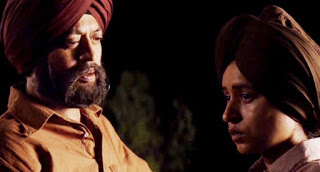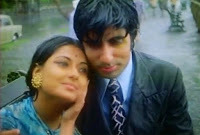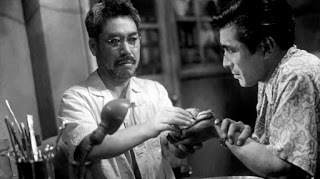Actorly pairings – expected ones and unusual ones
[Did this for Mint Lounge]
-----------------
Watching Saket Chaudhary’s Hindi Medium a few weeks ago, I found myself momentarily whisked away to another filmic universe. This happened when Irrfan Khan, playing a father who is trying to get his daughter into a good English-medium school, and Tillotama Shome, in a supporting role as a disdainful counsellor, first appeared together on screen. I had a hard time concentrating on the scene because my mind went back to the last time I had seen these two actors share a frame – in a vastly different sort of film in which they played very different roles.
 In Anup Singh’s mesmerizing 2013 film
Qissa: Tale of a Lonely Ghost
, set just after Partition, Irrfan is a Sikh patriarch who, without heeding any counsel or acknowledging his duplicity even to himself, pretends that his newborn daughter is a son; Shome (in a stunning performance) is this unfortunate in-between, her life as partitioned as the newly independent country she is living in.
In Anup Singh’s mesmerizing 2013 film
Qissa: Tale of a Lonely Ghost
, set just after Partition, Irrfan is a Sikh patriarch who, without heeding any counsel or acknowledging his duplicity even to himself, pretends that his newborn daughter is a son; Shome (in a stunning performance) is this unfortunate in-between, her life as partitioned as the newly independent country she is living in.
As a movie nerd who likes to connect dots, one might half-jokingly note that both these stories are about challenges facing parents. But the differences are much more pronounced. Qissa was a great big-theatre film, an intense widescreen experience that also, paradoxically, manages to feel claustrophobic. It is shot in dark, muted colours; even the daytime scenes have a stygian, oppressive feel to them. Hindi Medium, on the other hand, is bright and colourful, not least because of its depiction of the main family’s flashy, nouveau-riche lifestyle. It is an upbeat, fast-paced portrayal of modern life in a status-conscious world, while Singh’s film is a stately period work that finds exactly the right tone and pace to tell the story of a family frozen in time.
In comparing these two instances of co-stars in disparate films, I’m not trying to make a point about acting versatility (though Khan and Shome are both terrific performers, well capable of inhabiting a range of roles). It’s just that I was reminded of the effect our knowledge of an actor’s history can have on our viewing experience: how seeing the same performers in a variety of roles or situations can help one appreciate different filmmaking styles or sensibilities.
There are variations on this, of course. When watching a well-established screen pairing over a period of time, there might be a strong component of nostalgia involved. For example, we see Katharine Hepburn and Spencer Tracy together as classic Hollywood matinee idols performing a love-hate waltz in Woman of the Year (1942) – and then again as a long-married couple in Guess Who’s Coming to Dinner 25 years later (with Tracy, who died just after the film’s completion, looking haggard and older than he really was) – and we become aware not just that glamorous, larger-than-life stars are mortal, but of our own aging process and how it affects the way we experience films. Something similar happens when we see Farooque Shaikh and Deepti Naval as an elderly couple tentatively exploring romance in Listen…Amaya , with some prior knowledge of what these actors were like decades earlier in films like Chashme Baddoor and Saath Saath.
 With cinema getting more self-referential by the year, there are also cases of contemporary directors wittily playing off or subverting our expectations of an old pairing. One of the most indelible images from the Middle Cinema of the 1970s was Amitabh Bachchan and Moushumi Chatterjee splashing through rain-drenched south Bombay in Manzil, while “Rim Jhim Gire Saawan” played on the soundtrack and KK Mahajan’s camera performed a dizzying dance around them – a marvelous portrayal of romantic love in a city that might swallow the lovers up at any moment. It’s likely that the director Shoojit Sircar and the writer Juhi Chaturvedi – both of whom were fans of the Middle Cinema – had those images in mind when they cast Chatterjee as Bachchan’s sister-in-law (with whom he is always bickering) in Piku, a film where the character name Bhaskor Banerjee was also a nod to Bachchan’s role in another major work of that decade, Anand.
With cinema getting more self-referential by the year, there are also cases of contemporary directors wittily playing off or subverting our expectations of an old pairing. One of the most indelible images from the Middle Cinema of the 1970s was Amitabh Bachchan and Moushumi Chatterjee splashing through rain-drenched south Bombay in Manzil, while “Rim Jhim Gire Saawan” played on the soundtrack and KK Mahajan’s camera performed a dizzying dance around them – a marvelous portrayal of romantic love in a city that might swallow the lovers up at any moment. It’s likely that the director Shoojit Sircar and the writer Juhi Chaturvedi – both of whom were fans of the Middle Cinema – had those images in mind when they cast Chatterjee as Bachchan’s sister-in-law (with whom he is always bickering) in Piku, a film where the character name Bhaskor Banerjee was also a nod to Bachchan’s role in another major work of that decade, Anand.
At other times, the same director may use two actors in subtly similar ways in different situations. Most film enthusiasts know Akira Kurosawa’s medieval-era epic The Seven Samurai, in which the veteran Takashi Shimura plays the wise, grizzled, somewhat weary leader of the samurai while the younger Toshiro Mifune is the snarling upstart who wants to become a part of the group (and must be kept in check by the older man). But many years before that, in a film set in contemporary Japan – Drunken Angel – Kurosawa had already begun the process of creating a mould for the two actors: Shimura was a jaded doctor who serves as a mentor and guiding light for Mifune’s brash young gangster.
must be kept in check by the older man). But many years before that, in a film set in contemporary Japan – Drunken Angel – Kurosawa had already begun the process of creating a mould for the two actors: Shimura was a jaded doctor who serves as a mentor and guiding light for Mifune’s brash young gangster.
To watch these two films next to each other is to see how a director might show versatility in one sense (that is, making movies with different subject matter and settings) while also achieving an authorial consistency in another respect – through the carefully worked out use of screen personalities whom a viewer can recognize, relate to and incorporate into their experience of a film.
--------------------------------------
[Related posts: Qissa, Listen... Amaya, Familiarity breeds affection]
-----------------
Watching Saket Chaudhary’s Hindi Medium a few weeks ago, I found myself momentarily whisked away to another filmic universe. This happened when Irrfan Khan, playing a father who is trying to get his daughter into a good English-medium school, and Tillotama Shome, in a supporting role as a disdainful counsellor, first appeared together on screen. I had a hard time concentrating on the scene because my mind went back to the last time I had seen these two actors share a frame – in a vastly different sort of film in which they played very different roles.
 In Anup Singh’s mesmerizing 2013 film
Qissa: Tale of a Lonely Ghost
, set just after Partition, Irrfan is a Sikh patriarch who, without heeding any counsel or acknowledging his duplicity even to himself, pretends that his newborn daughter is a son; Shome (in a stunning performance) is this unfortunate in-between, her life as partitioned as the newly independent country she is living in.
In Anup Singh’s mesmerizing 2013 film
Qissa: Tale of a Lonely Ghost
, set just after Partition, Irrfan is a Sikh patriarch who, without heeding any counsel or acknowledging his duplicity even to himself, pretends that his newborn daughter is a son; Shome (in a stunning performance) is this unfortunate in-between, her life as partitioned as the newly independent country she is living in. As a movie nerd who likes to connect dots, one might half-jokingly note that both these stories are about challenges facing parents. But the differences are much more pronounced. Qissa was a great big-theatre film, an intense widescreen experience that also, paradoxically, manages to feel claustrophobic. It is shot in dark, muted colours; even the daytime scenes have a stygian, oppressive feel to them. Hindi Medium, on the other hand, is bright and colourful, not least because of its depiction of the main family’s flashy, nouveau-riche lifestyle. It is an upbeat, fast-paced portrayal of modern life in a status-conscious world, while Singh’s film is a stately period work that finds exactly the right tone and pace to tell the story of a family frozen in time.
In comparing these two instances of co-stars in disparate films, I’m not trying to make a point about acting versatility (though Khan and Shome are both terrific performers, well capable of inhabiting a range of roles). It’s just that I was reminded of the effect our knowledge of an actor’s history can have on our viewing experience: how seeing the same performers in a variety of roles or situations can help one appreciate different filmmaking styles or sensibilities.
There are variations on this, of course. When watching a well-established screen pairing over a period of time, there might be a strong component of nostalgia involved. For example, we see Katharine Hepburn and Spencer Tracy together as classic Hollywood matinee idols performing a love-hate waltz in Woman of the Year (1942) – and then again as a long-married couple in Guess Who’s Coming to Dinner 25 years later (with Tracy, who died just after the film’s completion, looking haggard and older than he really was) – and we become aware not just that glamorous, larger-than-life stars are mortal, but of our own aging process and how it affects the way we experience films. Something similar happens when we see Farooque Shaikh and Deepti Naval as an elderly couple tentatively exploring romance in Listen…Amaya , with some prior knowledge of what these actors were like decades earlier in films like Chashme Baddoor and Saath Saath.
 With cinema getting more self-referential by the year, there are also cases of contemporary directors wittily playing off or subverting our expectations of an old pairing. One of the most indelible images from the Middle Cinema of the 1970s was Amitabh Bachchan and Moushumi Chatterjee splashing through rain-drenched south Bombay in Manzil, while “Rim Jhim Gire Saawan” played on the soundtrack and KK Mahajan’s camera performed a dizzying dance around them – a marvelous portrayal of romantic love in a city that might swallow the lovers up at any moment. It’s likely that the director Shoojit Sircar and the writer Juhi Chaturvedi – both of whom were fans of the Middle Cinema – had those images in mind when they cast Chatterjee as Bachchan’s sister-in-law (with whom he is always bickering) in Piku, a film where the character name Bhaskor Banerjee was also a nod to Bachchan’s role in another major work of that decade, Anand.
With cinema getting more self-referential by the year, there are also cases of contemporary directors wittily playing off or subverting our expectations of an old pairing. One of the most indelible images from the Middle Cinema of the 1970s was Amitabh Bachchan and Moushumi Chatterjee splashing through rain-drenched south Bombay in Manzil, while “Rim Jhim Gire Saawan” played on the soundtrack and KK Mahajan’s camera performed a dizzying dance around them – a marvelous portrayal of romantic love in a city that might swallow the lovers up at any moment. It’s likely that the director Shoojit Sircar and the writer Juhi Chaturvedi – both of whom were fans of the Middle Cinema – had those images in mind when they cast Chatterjee as Bachchan’s sister-in-law (with whom he is always bickering) in Piku, a film where the character name Bhaskor Banerjee was also a nod to Bachchan’s role in another major work of that decade, Anand. At other times, the same director may use two actors in subtly similar ways in different situations. Most film enthusiasts know Akira Kurosawa’s medieval-era epic The Seven Samurai, in which the veteran Takashi Shimura plays the wise, grizzled, somewhat weary leader of the samurai while the younger Toshiro Mifune is the snarling upstart who wants to become a part of the group (and
 must be kept in check by the older man). But many years before that, in a film set in contemporary Japan – Drunken Angel – Kurosawa had already begun the process of creating a mould for the two actors: Shimura was a jaded doctor who serves as a mentor and guiding light for Mifune’s brash young gangster.
must be kept in check by the older man). But many years before that, in a film set in contemporary Japan – Drunken Angel – Kurosawa had already begun the process of creating a mould for the two actors: Shimura was a jaded doctor who serves as a mentor and guiding light for Mifune’s brash young gangster. To watch these two films next to each other is to see how a director might show versatility in one sense (that is, making movies with different subject matter and settings) while also achieving an authorial consistency in another respect – through the carefully worked out use of screen personalities whom a viewer can recognize, relate to and incorporate into their experience of a film.
--------------------------------------
[Related posts: Qissa, Listen... Amaya, Familiarity breeds affection]
Published on November 17, 2017 22:13
No comments have been added yet.
Jai Arjun Singh's Blog
- Jai Arjun Singh's profile
- 11 followers
Jai Arjun Singh isn't a Goodreads Author
(yet),
but they
do have a blog,
so here are some recent posts imported from
their feed.



